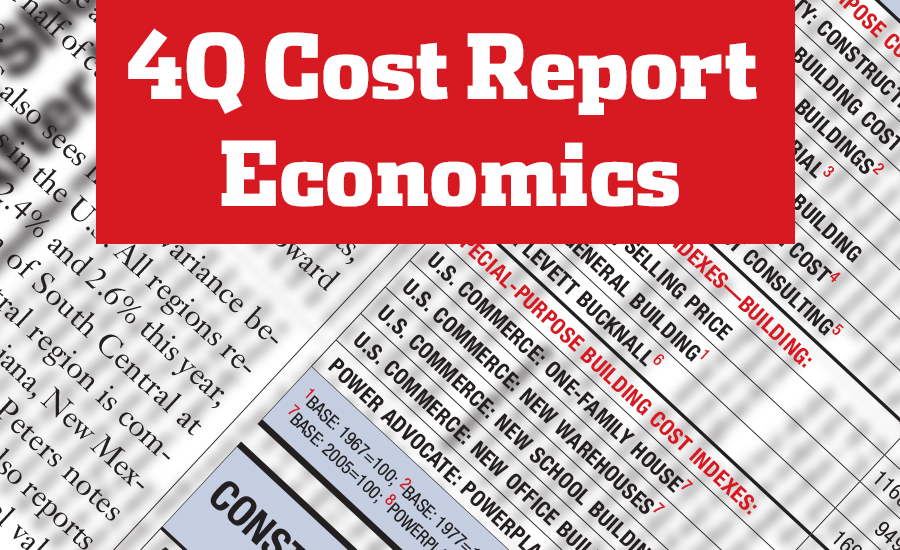Material and labor costs will continue a gradual upward climb in 2017, continuing to recover from recession lows. Even after the Federal Reserve’s small bump in the benchmark interest rate December 14, key costs should remain tame. That much said, there are potential wild cards that could throw off estimates, especially when it comes to steel.
Asphalt, which is made from oil, is an interesting example of stable price changes despite oil’s swings. Oil is gradually rebounding from lows that helped drive the price of asphalt paving mixtures and blocks down 3.2% and 5.5% in 2015 and 2016, respectively—far less than the fall of crude oil. Deni Koenhemsi, IHS Markit senor economist for price and purchasing, notes that because asphalt is an intermediate good that requires processing, asphalt prices never track oil’s ups and downs and “producers hold on to their asking number when [oil] prices are going up and down.”
But in 2017 a slow turnaround will begin, predicts IHS Markit. Asphalt paving mixtures should climb 1.3%, 2.3% and 2.6% over the next three years.
A post-recession rebound in gypsum prices will likely remain slow and uneven. Used extensively in residential construction, gypsum products shot up 12.5%, 14.7% and 7.5% from 2012 to 2014, but after inching up only .9% and 1.4% the following years, IHS Markit sees a potential 3% increase in 2017. In 2016 producers tried to push prices up in July but buyers resisted. “We think in 2017 they will have a bit more luck,” says Koenhemsi, adding that producers had already announced their intentions to reprice at higher levels in the first quarter.
|
Click Here to View the 4Q Cost Report PDF |
Cement to Head Up
Cement prices, which IHS Markit forecast accurately to increase 4.8% in 2016, should rise another 3.7% next year, the company predicts.
With some materials, annual averages mask potentially big quarter-to-quarter swings. Those swings complicate the issue of when to place orders.
Structural steel should level off after two years of decline but its market price involves uncertainty about weather— and the potential of U.S. producers to take advantage of increases in overseas markets. How does that work? Australia is the main source of iron ore and coal for China, Japan and Korea, where all the world’s cheap steel comes from, explains John Anton, director of steel analytics for IHS Markit. When tropical cyclones and flooding hits Australian mining or transportation, the material “doesn’t get where it’s needed,” he says, and “it blows up your budget.”
While most steel in the U.S. is made with scrap metal in electric-arc furnaces, U.S. producers tend to try to take advantage of Asian steel price increases by raising their own prices, says Anton.
IHS Markit sees structural steel, whose price had fallen in 2015 and 2016, increasing a tiny .3% next year, and rebar, which has also been falling, increasing 1.8% next year. But IHS Markit also sees those prices falling again in 2018.
The picture for all steel products is still more complicated. MetalMiner, another firm that tracks prices, said in October that with so many variables, “it’s hard to predict steel price direction in 2017.” Among the factors cited were China’s stimulus program and the U.S. Dept. of Commerce’s anti-dumping measure.
Labor costs won’t make a sudden, dramatic leap next year. Despite many worries by employers about staffing projects, the rates of increase should stay well below those seen prior to the recession, when annual increases topped 4%.
Based on settlements reported so far in 2016, the Construction Labor Research Council (CLRC) expects to see total compensation for union trades rise slightly from 2.6% in 2016 to 2.7% in 2017 and 2.8% in 2018.
“It’s a continuation of this very linear trend that we’ve seen,” says Carey Peters, executive director of CLRC. “Not a lot of zigs and zags in the line, just slow and steady increases.”
Another continuing trend is the need to put much of those increases toward fringe benefits. Peters estimates that while total compensation is roughly split as two-thirds wage and one-third fringe benefits, around half of current increases go toward benefits.
CLRC also sees limited variance between regions in the U.S. All regions reported between 2.4% and 2.6% this year, with the exception of South Central at 3%. The South Central region is comprised of Arkansas, Louisiana, New Mexico, Oklahoma and Texas. Peters notes that the South Central region also reports the lowest increases as a nominal value (dollar value). “They are trying to catch up,” he adds.
Some trades are seeing higher increases than other. CLRC reports that electricians saw the highest increase in 2016 at 3.4%, while plasterers saw the lowest at 2%.
Open-Shop Increases Steady
Open-shop labor is also seeing limited increases. Personnel Administration Services expects craft wage increases to remain at a flat 3.6% in 2017, the same rate it has reported since 2014. That rate of increase also remains well below pre-recession levels, which topped 5% in 2007.
The Federal Reserve, in raising its benchmark rate, hinted at more increases next year if the economy continues to grow or picks up speed. Whether that will happen can’t be known. But material costs all have their own personalities, and few, if any, are likely to change direction over monetary policy alone.



Post a comment to this article
Report Abusive Comment